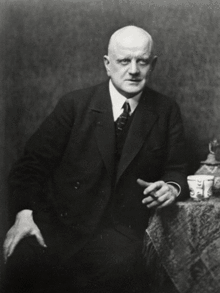Symphony No. 6 (Sibelius)
| Symphony No. 6 | |
|---|---|
| by Jean Sibelius | |
 Sibelius in 1923 | |
| Key | D minor (Dorian mode) |
| Catalogue | Op. 104 |
| Composed | 1918–23 |
| Premiere | |
| Date | 19 February 1923 |
The Symphony No. 6 in D minor, Op. 104, was a work of long gestation completed by Jean Sibelius in 1923. Although the score does not contain a key attribution, the symphony is usually described as being in D minor; much of it is in fact in the (modern) Dorian mode.[1] A typical performance lasts about 25 minutes. The composer called the work "cold spring water" in opposition to many contemporary "cocktails"—a reference to the modernist gestures in post-war music. The symphony was premiered by the Helsinki Philharmonic Orchestra, conducted by the composer, on 19 February 1923 and had other performances under his direction in the following months.[2]
Background[]
The last three symphonies by Sibelius abandon traditional development and are more a matter of structured emotional urges; in the words of a 1912 diary entry, "I intend to let the musical thoughts and their development determine their own form in my soul."[3] This was echoed in his interview in the Svenska Dagbladet after a performance of the Sixth in Stockholm in March 1923: "I do not think of a symphony only as music in this or that number of bars, but rather as an expression of a spiritual creed, a phase in one's inner life."[4] Although the symphony was completed only in 1923, musical ideas incorporated into it were being developed in his notebooks from 1914 onward, at the same time as he was also working on his Fifth Symphony; by 1918 it was taking more definite form, when he was working on the Seventh as well.[5] By January 1923 his diary notes the final completion of the first three movements of the Sixth. He conducted the premiere on 19 February of that year.
The symphony was dedicated to his Swedish musical advocate, the composer and conductor Wilhelm Stenhammar.
Instrumentation[]
The work is scored for 2 flutes, 2 oboes, 2 clarinets, bass clarinet, 2 bassoons, 4 horns, 3 trumpets, 3 trombones, harp, timpani and strings.
Structure[]
| External audio | |
|---|---|
| Performed by the Berlin Philharmonic under Herbert von Karajan | |
The symphony has four movements:
- Allegro molto moderato (in Dorian mode on D)
- Allegretto moderato (in Dorian mode on G)
- Poco vivace (in Dorian mode on D)
- Allegro molto (in Dorian mode on D—ends in Aeolian mode on D)
Reception[]
After the premiere, the symphony was described in the press as "a poem within the framework of a symphony".[6] Sibelius himself once remarked that it "always reminds me of the scent of the first snow".[7] In terms of the nature mysticism present in the works of Sibelius' final period, one commentator finds that the finale suggests “a kind of elemental archetype: a natural cycle rising to a peak... then declining into extinction, in the manner, perhaps, of a day, a season, a year, or a person’s life.”[8]
Because of its quiet qualities and the uncertainty of its key attribution, the Sixth has been described as "the Cinderella of the seven symphonies".[9] But like the poor sister, its unassuming qualities grow on the listener. As they did, for example, for Benjamin Britten, converting him from a fixation on the avant-garde composers who influenced him when younger.[10] It has also been claimed that one of the influences on the symphony was Giovanni Pierluigi da Palestrina, whose music the young Sibelius had studied.[11]
The first commercial recording of the Sixth Symphony was made by Georg Schnéevoigt with the Finnish National Orchestra on 8 June 1934 for HMV's Sibelius Society.[12]
References[]
- ^ (Pike 1974, 318–19)
- ^ Barnett 2007, pp.299–303
- ^ Hepokoski 2001, p.322
- ^ Barnett 2007, pp.301–302
- ^ Hepokoski 2001
- ^ Barnett 2007, p.299
- ^ "Sixth symphony op. 104 (1923)", official Sibelius website
- ^ Hepokoski 2001, p.251
- ^ By the musicologist Gerald Abraham, quoted on the official Sibelius website
- ^ Benjamin Britten, On Music, Oxford University 2003, p.277
- ^ Tomi Mäkelä, Jean Sibelius, The Boydell Press, 2011, p.4
- ^ Available on You Tube
Bibliography[]
- Abraham, Gerald. 1947. "The Symphonies". In The Music of Sibelius, edited by Gerald Abraham. New York: W. W. Norton. British edition, as Sibelius: A Symposium. London: L. Drummond, 1948.
- Barnett, Andrew, Sibelius, Yale University 2007, pp.299–303
- Hepokoski, James, “Rotations, sketches and the Sixth Symphony”, Sibelius Studies, Cambridge University 2001, pp.322–51
- Pike, Lionel. 1974. "Sibelius's Debt to Renaissance Polyphony". Music & Letters 55, no. 3 (July): 317–26.
- Pike, Lionel. 2001. "Tonality and Modality in Sibelius's Sixth Symphony". Tempo new series, no. 216 (April): 6–16.
- "Sixth symphony op. 104 (1923)", Article at official Sibelius website
External links[]
- Symphony No.6, Op.104: Scores at the International Music Score Library Project
- Symphonies by Jean Sibelius
- 1923 compositions
- Compositions in D minor